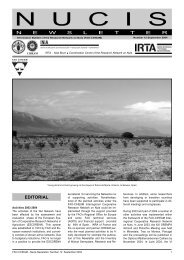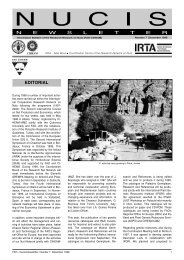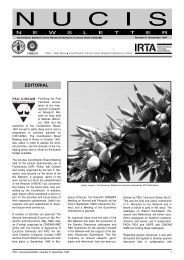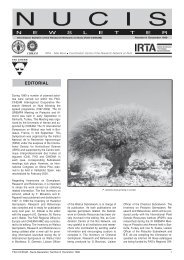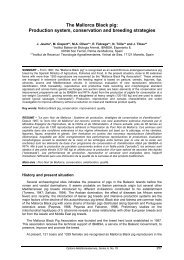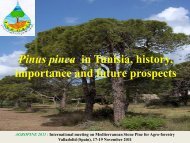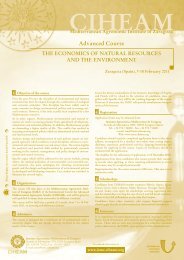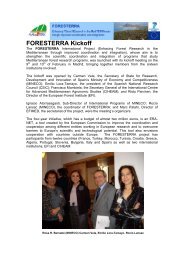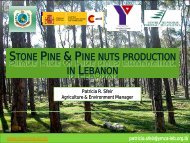NUCIS number 10. December 2001. 48 pages (full ... - IAMZ - ciheam
NUCIS number 10. December 2001. 48 pages (full ... - IAMZ - ciheam
NUCIS number 10. December 2001. 48 pages (full ... - IAMZ - ciheam
Create successful ePaper yourself
Turn your PDF publications into a flip-book with our unique Google optimized e-Paper software.
UPDATE OF THE SPANISH<br />
CHESTNUT INVENTORY<br />
OF CULTIVARS<br />
Abstract. Chestnut (Catanea sativa Mill.)<br />
is a minor crop in Spain but important in<br />
some hilly areas. Until now we had found<br />
chestnut cultivars in Andalucía, Asturias,<br />
Castilla-León, Extremadura and Galicia.<br />
In the Canary Islands the presence of<br />
chestnut was described in the fifties but<br />
not its culture for nut production. During<br />
the last two years we have been surveying<br />
chestnuts in Tenerife, La Palma, Gran<br />
Canaria and El Hierro. In all islands we<br />
found old orchards with local chestnut<br />
cultivars, but it was only possible to identify<br />
some in Tenerife, La Palma and El<br />
Hierro. In Gran Canaria chestnut crop<br />
exists in the Northern slopes but growers<br />
do not recognize any longer their cultivars<br />
though they remember their grandparents<br />
grafting seedlings with local cultivars. Up<br />
to date we have found in Spain 210 local<br />
cultivars denominations, 23 of them cultivated<br />
in more than one region. We are<br />
now including cuttings in the National<br />
Germplasm Bank located in Galicia, and<br />
we are characterizing them by morphology<br />
and molecular markers to identify them<br />
and to select the best to maintain the<br />
Spanish chestnut production.<br />
Key words. germplasm resources, variability,<br />
local cultivars<br />
INTRODUCTION<br />
Chestnut (Castanea sativa Mill.) is a minor<br />
crop in Spain, but it is important for<br />
the economy in hilly areas for nut and timber<br />
production. In most of the areas where<br />
chestnut is present, it appears naturalized<br />
and cultivated. Most of the chestnut<br />
plantings grown in Spain are found in the<br />
Northwestern part of the country in the regions<br />
of Galicia, Asturias and Castilla-<br />
León (Fig. 1). Previous papers have listed<br />
cultivars in Galicia (Fernández and Pereira,<br />
1994; Pereira-Lorenzo and Fernández-López,<br />
1997), Asturias (Fernández-<br />
Lamuño, 1984, Pereira et al., 2001), Castilla-León,<br />
Extremadura, and Andalucía<br />
(Pereira et al., 2001). Our long-term goal<br />
has been to establish a National Germplasm<br />
Bank of the genus Castanea and<br />
characterize the Spanish chestnut cultivars<br />
to select the most interesting for nut<br />
and/or timber production.<br />
In País Vasco and Navarra, chestnut orchards<br />
have been destroyed by chestnut<br />
blight disease, caused by the fungus<br />
Cryphonectria parasitica (Murr.) Barr,<br />
which was surely introduced with Asian<br />
chestnut seeds in 1914 and 1940 (Elorrieta,<br />
1949), although it was first reported in<br />
1943 (Colinas and Uscuplic, 1999). In Catalonia,<br />
coppice is predominant and orchards<br />
have been abandoned for a long<br />
time.<br />
In June of 2000 we started to study the<br />
chestnut culture in Tenerife, Canary Islands<br />
(Fig. 1). In 1949, Elorrieta reported<br />
the presence of chestnut in Canary Islands,<br />
which is common in other Atlantic<br />
archipelagos as Azores and Madeira. In<br />
July of 2001 we sampled La Palma and El<br />
Hierro islands, with the aim to complete<br />
the study. Our objectives were to localise<br />
the cultivars in Canary Islands to finish<br />
the Spanish Inventory of chestnut cultivars<br />
(Pereira et al., 2001), to characterise<br />
cultivars morphologically and isoenzymatically,<br />
and to introduce them in the Spanish<br />
chestnut Germplasm Bank. In this<br />
work the <strong>number</strong> of cultivars existing in<br />
Spain, especially in the Canary Islands is<br />
updated.<br />
Figure 2. Distribution of chestnut<br />
cultivars in Tenerife (Canary Islands)<br />
N<br />
Figure 1. Chestnut growing areas in Spain<br />
FRANCE<br />
N<br />
5 Km.<br />
0 Km.<br />
5 Km.<br />
Ravelo<br />
La Matanza<br />
La Victoria<br />
Puerto de la Cruz<br />
Dh R MCg Dpa<br />
M RCg<br />
T M Do M Gr R Ma<br />
Pg<br />
MtP<br />
Pi Pc<br />
La Orotava Gr Ar M<br />
M<br />
Ds<br />
Arafo<br />
PARQUE NACIONAL<br />
DEL TEIDE<br />
Ar<br />
Cr<br />
La Esperanza<br />
Mo<br />
SANTA CRUZ<br />
DE TENERIFE<br />
Arafero Mt Matancero<br />
Corujero Mo Mollar<br />
Cg Castagrande M Mulato<br />
Dh Del haya Pc Pico Claro<br />
Dpa De pata P Picudo<br />
Ds De Sala Pi Piñero<br />
Do Donosa Pg Polegre<br />
Cir Cirande R Redondo<br />
Ma Manso T Temprano<br />
PORTUGAL<br />
SPAIN<br />
Figure 3. Distribution of chestnut<br />
cultivars in La Palma (Canary Islands)<br />
GARAFIA<br />
N<br />
Pe<br />
Ma Cueva de Agua<br />
Po<br />
El Romeral<br />
L<br />
SAN ANDRES<br />
Y SAUCES<br />
Hoya Grande<br />
Barranco de El Agua<br />
PARQUE NACIONAL<br />
CALDERA DE<br />
TABURIENTE<br />
Canary Islands<br />
MARROCO<br />
AFRICA<br />
Pl<br />
Llano de las Cuevas<br />
J<br />
M<br />
Ch Pl P<br />
Ch<br />
Pq<br />
EL PASO Me Tb<br />
Pl<br />
N J<br />
L<br />
Cabeza de Vaca<br />
Bl<br />
SANTA CRUZ<br />
DE LA PALMA<br />
BREÑA ALTA<br />
La PalmaTenerife<br />
Gomera Gran Canaria<br />
Hierro<br />
SAHARA<br />
Bl Blanco<br />
Ch Chocho<br />
J Jabudo<br />
L Lisio<br />
M Macho<br />
Ma Manso<br />
Me Menudo<br />
N Negro<br />
P Picuda<br />
Pe Peludo<br />
Pl Peloño<br />
Po Pelon<br />
Pq Piquenta<br />
Tb Tablon<br />
5 Km.<br />
5 Km. 0 Km.<br />
34 FAO-CIHEAM - Nucis-Newsletter, Number 10 <strong>December</strong> 2001



